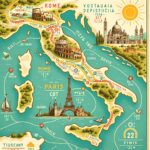Are you planning a trip to Paris and Italy? Choosing the best time to travel can significantly enhance your experience in these picturesque destinations. From exploring iconic landmarks to savoring authentic cuisine, timing plays a crucial role in making the most of your vacation. Whether you prioritize pleasant weather, cultural events, or budget-friendly options, understanding the timing of your trip is essential.
In Paris and Italy, the weather varies dramatically throughout the year, impacting the activities you can enjoy during your stay. From sunny days ideal for outdoor sightseeing to cozy evenings perfect for indulging in local delicacies, each season offers a unique charm that caters to different preferences. To make informed decisions about when to visit these stunning locations, it’s essential to consider both countries’ climate patterns and how they align with your travel goals.
Furthermore, understanding the high season versus low season dynamics in Paris and Italy is vital for optimizing your travel experience. While peak times may offer bustling atmospheres and vibrant events, they also come with higher prices and larger crowds.
On the other hand, visiting during off-peak periods can provide a more tranquil ambiance and better deals but might limit certain attractions or experiences. By weighing the pros and cons of each season, you can select the ideal time that aligns with your preferences and priorities for exploring these European gems.
Weather and Climate Overview in Paris and Italy Throughout the Year
When planning a trip to Paris and Italy, understanding the weather and climate throughout the year is crucial. The best time to travel to Paris and Italy largely depends on your preferences for weather and what activities you want to do during your visit. Both destinations experience distinct seasons, each offering unique experiences for travelers.
In Paris, the best time to visit is typically during the spring (April to June) or fall (September to October) when the weather is mild, and the crowds are not as overwhelming as in the peak summer months. Italy, on the other hand, sees peak tourist season from June to August when the weather is hot and sunny. However, if you prefer fewer crowds and more pleasant temperatures for sightseeing, consider traveling in the shoulder seasons of spring or fall.
One of the key factors influencing your decision on when to travel to Paris and Italy will be the weather conditions at that time of year. Understanding the climate patterns can help you pack appropriately and plan your activities accordingly. Whether you aim to explore historical landmarks, relax on beautiful beaches, or indulge in local cuisine, knowing what weather to expect can enhance your overall travel experience.
| Paris | Italy |
|---|---|
| Spring (April-June): Mild weather with blooming flowers | Peak Season (June-August): Hot and sunny weather with crowded tourist attractions |
| Fall (September-October): Pleasant temperatures with colorful foliage | Shoulder Seasons (Spring/Fall): Fewer crowds and ideal sightseeing conditions |
High Season vs Low Season
When planning a trip to Paris and Italy, one of the crucial factors to consider is whether you want to visit during high season or low season. Each option has its own set of pros and cons that can greatly influence your overall travel experience. The best time to travel to Paris and Italy depends on your preferences, budget, and tolerance for crowds.
During the high season in Paris and Italy, typically in the summer months from June to August, you can expect beautiful weather with warm temperatures perfect for exploring outdoor attractions. Tourist sites are generally open longer hours, allowing you to make the most out of your visit. However, this also means larger crowds, higher prices for accommodations and tours, and sometimes difficulty securing reservations at popular restaurants.
On the other hand, traveling during the low season in Paris and Italy, which is usually from November to March excluding holidays like Christmas and New Year’s, can offer a more peaceful experience with fewer tourists. You may also find better deals on hotels and flights during this time.
While the weather may be cooler and some outdoor attractions may have limited hours or be closed altogether, you’ll have the opportunity to see these destinations in a different light without the hustle and bustle of peak tourism.
Despite some trade-offs between high season and low season travel, both options can provide unique experiences in Paris and Italy. Whether you prefer sunny days at crowded landmarks or cozy evenings exploring hidden gems without the tourist crowds, understanding the pros and cons of each season will help you choose the best time to travel according to your personal preferences.
| Pros of High Season | Cons of High Season |
|---|---|
| Beautiful weather for outdoor activities | Larger crowds |
| Extended opening hours for tourist sites | Higher prices for accommodations |
Festivals and Events
When planning a trip to Paris and Italy, considering the festivals and events that take place throughout the year can enhance your experience and immerse you in the local culture. From food festivals to music events, each region has its own unique celebrations that showcase the best of what these destinations have to offer. Here are some of the best times to experience local culture in Paris and Italy:
- Paris: One of the most popular events in Paris is La Fête de la Musique, a city-wide street music festival held on June 21st. The entire city comes alive with free concerts and performances in various neighborhoods, making it a vibrant time to visit for music lovers. Another must-see event is Bastille Day on July 14th, where you can witness impressive fireworks displays at iconic landmarks like the Eiffel Tower.
- Italy: In Italy, one of the most famous festivals is Carnevale di Venezia (Venice Carnival), which takes place in Venice leading up to Lent. This extravagant celebration is known for its elaborate masks, costumes, and grand masquerade balls. For wine enthusiasts, visiting during Vinitaly in Verona in April offers a chance to sample some of Italy’s finest wines and attend wine tastings.
– Both destinations also offer religious celebrations such as Easter processions and Christmas markets that provide insight into local traditions and customs. By aligning your travel dates with these festivals and events, you can truly immerse yourself in the cultural fabric of Paris and Italy.
Whether you’re interested in art exhibitions, culinary showcases, or traditional folk performances, timing your visit to coincide with these festivals can add an extra layer of depth to your travel experience. Be sure to research upcoming events and plan your trip accordingly to make the most of your time exploring all that Paris and Italy have to offer in terms of cultural richness and diversity.
Budget-Friendly Travel
When planning a trip to Paris and Italy, considering the best time to travel can not only ensure ideal weather conditions but also help you save money on your vacation. Finding deals and discounts based on the time of year can make your dream European getaway more affordable and enjoyable. From airfare and accommodations to local attractions and dining options, timing can significantly impact your overall expenses during your travels.
Off-Peak Season Savings
Traveling during the off-peak season, typically in the fall or winter months, can offer significant savings for budget-conscious travelers. With fewer tourists crowding popular landmarks and attractions, hotels and airlines often lower their prices to attract visitors during these quieter periods. Additionally, restaurants may offer special promotions or discounted meals to entice diners during slower times of the year. By taking advantage of these off-peak season savings, you can experience Paris and Italy without breaking the bank.
Last-Minute Deals
Flexibility with your travel dates can lead to finding last-minute deals and discounts that are perfect for spontaneous travelers looking to explore Paris and Italy on a budget. Airlines may reduce ticket prices closer to departure dates to fill empty seats on flights, while hotels offer discounted rates on rooms that have not been booked in advance.
Keep an eye out for flash sales, limited-time promotions, or package deals that include accommodations, tours, and other extras at a discounted rate. Being open to booking last-minute can result in unexpected savings on your European adventure.
Utilizing Travel Rewards and Loyalty Programs
If you are a frequent traveler or have credit cards with travel rewards programs, consider using your accumulated points or miles to offset costs during your trip to Paris and Italy. Many airlines and hotels offer loyalty programs that allow members to redeem points for free flights, hotel stays, upgrades, or other perks that can contribute to significant cost savings.
Additionally, booking through travel reward portals or using affiliated credit cards can provide exclusive discounts or bonus points that you can use towards future travel expenses. By maximizing these benefits offered through travel rewards programs, you can make your journey to Paris and Italy more economical while still enjoying a memorable vacation experience.
Crowds and Tourist Attractions
When planning a trip to popular tourist destinations like Paris and Italy, the timing of your visit can significantly impact your overall experience. Understanding how crowds and tourist attractions are affected by the season can help you make the most of your travels and avoid potential disappointments. Here’s a breakdown of how timing can influence your trip to these iconic destinations:
- High Season:
- Low Season:
- Shoulder Season:
During peak travel times, such as summer in Europe, popular attractions in Paris and Italy can be overcrowded with tourists. Long lines, crowded museums, and difficulty securing reservations at top restaurants are common challenges during high season. However, this time of year also offers longer daylight hours for sightseeing and a vibrant atmosphere with street performances and outdoor events.
Visiting during the off-peak months can provide a more relaxed and authentic experience in Paris and Italy. While some tourist sites may have shortened hours or undergo renovations during the low season, you’ll have fewer crowds to contend with. This is an ideal time to explore hidden gems, engage with locals, and enjoy discounts on accommodations and activities.
The shoulder seasons, typically spring and fall, can offer a balance between manageable crowds and favorable weather conditions in both Paris and Italy. During this time, you can enjoy pleasant temperatures for outdoor activities while avoiding the peak tourism rush. Plus, many festivals and cultural events take place during the shoulder seasons, providing unique opportunities to immerse yourself in local traditions.
Finding the best time to travel to Paris and Italy ultimately depends on your preferences for crowd levels, weather conditions, and budget considerations. Whether you choose to embrace the hustle and bustle of high season or opt for a quieter visit during low season, each period offers distinct advantages for exploring these enchanting destinations. Be sure to consider factors like seasonal activities, events, and insider tips from locals when deciding on the ideal timing for your trip.
Seasonal Activities
When planning a trip to Paris and Italy, it is essential to consider the seasonal activities available throughout the year. Each season offers unique outdoor adventures, culinary experiences, and sightseeing opportunities that can enhance your travel experience in these vibrant destinations.
Spring
In spring, both Paris and Italy come alive with blossoming flowers, pleasant temperatures, and outdoor festivities. This is the best time to travel to Paris and Italy if you enjoy exploring gardens such as the Luxembourg Gardens in Paris or the Villa Borghese Gardens in Rome. Spring also marks the beginning of outdoor dining season, allowing you to savor al fresco meals at charming cafes and restaurants.
Summer
Summer is a popular time for travelers to visit Paris and Italy due to the warm weather and longer daylight hours. This season is ideal for beachgoers heading to coastal regions like the Amalfi Coast or soaking up the sun along the Seine River in Paris. Additionally, summer offers an abundance of food festivals, concerts, and art exhibitions that showcase the rich cultural heritage of these destinations.
Fall
Autumn brings a tapestry of colors to Paris and Italy as leaves change hues, creating a picturesque backdrop for outdoor adventures. Fall is perfect for hiking in Tuscany’s rolling hills, enjoying wine tours in Bordeaux, or attending harvest festivals in Provence. If you’re a foodie, fall is also when truffle season begins in Italy, offering a unique culinary experience not to be missed.
By considering seasonal activities when planning your trip to Paris and Italy, you can tailor your itinerary to make the most of what each season has to offer. Whether you prefer basking in the Mediterranean sun during summer or marveling at fall foliage while indulging in regional cuisine, timing your visit strategically will ensure a memorable travel experience.
Insider’s Tips
When planning your trip to Paris and Italy, it’s essential to consider the advice from locals on the best time to visit these stunning destinations. Locals can offer valuable insights into when to experience each location at its finest, avoiding crowds and maximizing your overall experience.
In Paris, many locals recommend visiting during the shoulder seasons of spring (April to June) and fall (September to November). During these times, the weather is mild, and the crowds are thinner compared to the peak summer months. Additionally, you’ll have a chance to witness the beautiful cherry blossoms in bloom during spring or enjoy the vibrant autumn foliage in fall.
In Italy, locals often suggest traveling in late spring (May/June) or early fall (September/October) for the best experience. This period offers pleasant weather for exploring historic sites like Rome or Venice without feeling overwhelmed by tourists. Moreover, you can savor regional cuisine at outdoor markets and festivals celebrating local traditions. By following local recommendations on when to visit Paris and Italy for the best experience, you can make the most out of your travels and create unforgettable memories.
Frequently Asked Questions
What Is the Best Month to Go to Paris?
The best month to go to Paris is generally considered to be in the spring, specifically from April to June. During this time, the weather is mild, and the city’s famous gardens and outdoor cafes are in full bloom.
What Is the Best Month to Visit Italy?
The best month to visit Italy depends on personal preferences, but many people recommend visiting during the months of April, May, September, or October. These months offer pleasant weather, fewer crowds, and lower prices compared to the peak summer months.
What Is the Cheapest Time to Go to Paris?
The cheapest time to go to Paris is typically during the winter months from November to February. During this time, airfare and accommodation prices tend to be lower due to fewer tourists. However, it’s important to keep in mind that some attractions may have reduced hours or be closed during this period.

I’m a passionate traveler, writer, and Italophile. My fascination with Italy’s history, art, and culture has led me on countless adventures across the Italian landscape. Through “I Live Italy,” I share my love for this extraordinary country and aims to inspire others to explore its boundless beauty.





